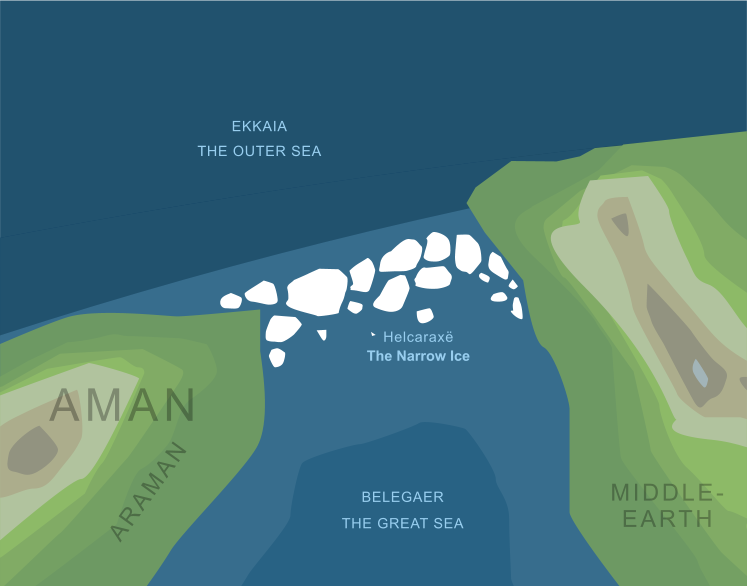- Cities and buildings
- Fields, plains and deserts
- Forests
- Hills and mountains
- Islands and promontories
- Lands, realms and regions
- Rivers and lakes
- Seas and oceans


 |
||||||
|


Which personality type are you?
Take the Free mydiscprofile Personality Test to discover your core personality and your ideal job.   Which personality type are you? |
|
Dates
Presumably at least partially destroyed at the end of the First Age1
Location
The far North of the world, bridging the lands of Aman and Middle-earth
Other names
Indexes: About this entry:
|

During the Elder Days, when the western continent of Aman was still present in the world, it was, for the most part, separated from Middle-earth by the wide waters of the Great Sea. In the far frozen North, however, the lands to the West and East bent together, and between them lay only a narrow strait. There the waters of the Great Sea mingled with those of the Outer Sea beyond, and the two landmasses were separated only by a field of frozen, shifting hills of ice. This was the Helcaraxë, the Grinding Ice, also known poetically as the Narrow Ice. This field of jagged ice provided a means by which those with sufficient power could pass from the West into the Hither Lands. After the Darkening of Valinor, Melkor and Ungoliant travelled to the Narrow Ice as they fled from the Valar. From the mist-shrouded land of Oiomúrë they crossed onto the ice (which indeed said to have been formed in part by the work of Melkor in the ancient past) and so passed into Middle-earth, coming ashore far northward of the Firth of Drengist. For lesser beings, however, the sheer ice presented much greater peril, and indeed it was thought to be impassable by the Elves. As the Noldor departed from Aman and made the long journey to return to Middle-earth, their leader Fëanor sailed across the northern straits in the vessels of the Teleri, but he chose to burn those ships and leave the following of Fingolfin stranded on the western coasts. Refusing to abandon the journey, the people of Fingolfin wandered for a time among the cold mists of Oiomúrë, but eventually determined to attempt the deadly crossing of the ice. Led by Fingolfin, Finrod and Galadriel, they set out into the Narrow Ice and marched to Middle-earth. As they began their journey, behind them the Moon first rose from Valinor into the sky.2 The crossing proved to be deadly indeed, and many of the Noldor were lost on ice fields, perhaps most notably Elenwë the wife of Fingolfin's son Turgon. Nonetheless the Noldor endured their harrowing struggle to cross the Narrow Ice, and as they set foot in Middle-earth at last, the Sun first appeared to bring light across the world. After the passage of Fingolfin and his people into Middle-earth, the Narrow Ice does not appear again in the legends of the Silmarillion. According to Bilbo Baggins' "Song of Eärendil", recited long afterward in Rivendell, Eärendil the Mariner voyaged so far north that he approached the Narrow Ice in his journey to find a way to Valinor, before eventually reaching the more southerly coasts of Aman and asking the aid of the Valar. Indeed, this poem by Bilbo Baggins is the only recorded use of the name 'Narrow Ice'; in the Silmarillion, the frozen strait is more usually referred to by its Elvish name of the Helcaraxë, or by its more direct translation of the 'Grinding Ice'. Notes
Indexes: About this entry:
For acknowledgements and references, see the Disclaimer & Bibliography page. Original content © copyright Mark Fisher 2002, 2016, 2018, 2023. All rights reserved. For conditions of reuse, see the Site FAQ. Website services kindly sponsored by Discus from Axiom Software Ltd.Discus is the perfect Job Matching tool, with a reference library of nearly 250 different roles. |